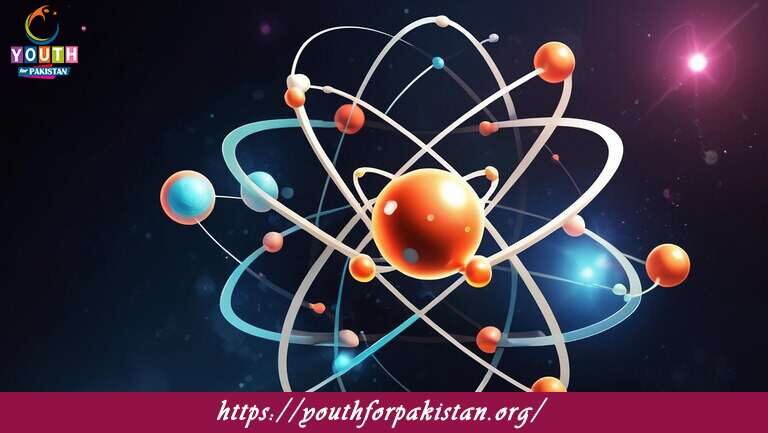10th Class Physics Chapter 18 Quiz with Answers

“10th Class Physics Chapter 18 Quiz: Atomic and Nuclear Physics” explores the intricate structure of atoms and the powerful phenomena occurring within their nuclei. This chapter is critical for MDCAT students as it gives them a basic understanding of atomic models, nuclear energy, and their applications in medicine and energy production. Our MDCAT Quiz for this chapter is designed to test and enhance your understanding of these concepts.
The chapter starts with the discussion of the atomic structure, focusing on the composition of atoms: protons, neutrons, and electrons. Students will study Rutherford’s model of the atom and how it evolved into Bohr’s model, which explains electron energy levels and emission spectra. The chapter then introduces the concept of radioactivity, describing the emission of alpha, beta, and gamma rays and the decay law governing radioactive materials. Much emphasis is given to nuclear reactions, including fission and fusion, in relation to their role in energy production and weaponry. Real-life applications of nuclear physics, such as in nuclear reactors and radiotherapy, are also discussed.
MDCAT Quiz: Test Your Knowledge of Atomic and Nuclear Physics
The MDCAT Quiz for Chapter 18 includes questions on atomic models, types of radioactive decay, and nuclear reactions. These questions present the learner with an opportunity to apply theoretical concepts to problems and analyze practical scenarios, such as calculating half-lives and understanding the principles of nuclear reactors. Regular practice ensures a strong grasp of atomic and nuclear physics, which is necessary for success in the MDCAT.
- Test Name: 10th Class Physics Chapter 18 Quiz
- Type: Quiz Test
- Total Questions: 30
- Total Marks: 30
- Time: 30 minutes
Note: Answer of the questions will change randomly each time you start the test, once you are finished, click the View Results button.
Free Flashcards for Atomic and Nuclear Physics
Use free flashcards to enhance your preparation for Chapter 18. Flashcards are available for key topics such as Bohr’s model, types of radioactive decay, nuclear fission, nuclear fusion, and radioactive isotopes. Flashcards provide an easy and quick way to review important concepts and memorize crucial definitions and formulas for the MDCAT exam.

The process of converting mass into energy in the sun and other stars is called ____________.
Nuclear fusion

The type of radiation that consists of high-energy particles, such as protons or neutrons, emitted from the nucleus of an atom is called ____________.
Particle radiation

The process of converting mass into energy in the sun and other stars is called ____________.
Nuclear fusion

The type of radiation that consists of high-energy particles, such as protons or neutrons, emitted from the nucleus of an atom is called ____________.
Particle radiation

The process of converting mass into energy in the sun and other stars is called ____________.
Nuclear fusion

The type of radiation that consists of high-energy particles, such as protons or neutrons, emitted from the nucleus of an atom is called ____________.
Particle radiation

The process of converting mass into energy in the sun and other stars is called ____________.
Nuclear fusion

The type of radioactive decay in which an unstable nucleus emits a positron is called ____________.
Positron emission

The type of radiation that consists of high-energy particles, such as protons or neutrons, emitted from the nucleus of an atom is called ____________.
Particle radiation

The type of radiation that can be stopped by several centimeters of lead or concrete is ____________.
Gamma radiation

The process of combining two light nuclei to form a heavier nucleus releases a large amount of ____________.
Energy

The type of radiation that can be stopped by a few millimeters of aluminum or plastic is ____________.
Beta radiation

The type of radiation that can penetrate several centimeters of lead is ____________.
Gamma radiation

The process of determining the identity and relative abundance of isotopes in a sample is called ____________.
Mass spectrometry

The type of radiation that can be stopped by a sheet of paper or a few centimeters of air is ____________.
Alpha radiation

The half-life of a radioactive isotope is the time it takes for ____________.
Half of the nuclei in a sample to decay

The type of radiation that consists of helium nuclei emitted from the nucleus of an atom is called ____________.
Alpha radiation

The number of neutrons in an atom is determined by subtracting the ____________ from the mass number.
Atomic number

The process of determining the age of an object by measuring the amount of a radioactive isotope it contains is called ____________.
Radiometric dating

The type of radioactive decay in which an unstable nucleus emits a beta particle is called ____________.
Beta decay

The type of radiation that consists of fast-moving electrons emitted from the nucleus of an atom is called ____________.
Beta radiation

The type of radioactive decay in which an unstable nucleus emits an alpha particle is called ____________.
Alpha decay
Experience the real exam environment with our expertly designed collection of over 25,000 MCQs MDCAT Mock Tests.





